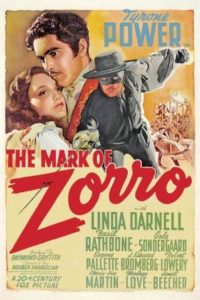Ride With Zorro . . . The Dashing Don Of California’s Most Adventurous Era!
When one thinks of Hollywood’s greatest swashbuckler, invariably the name that comes back is Errol Flynn. And deservedly so, perhaps. But there have been others, ranging from Douglas Fairbanks to Burt Lancaster to Yul Brynner. All have tried on the rapier (or cutlass) for size. However, the only actor with any real potential to challenge Flynn’s swashbuckling crown is one Tyrone Edmund Power, Jr. So let’s go back for a moment….to 1939.
Oh, and let’s point out this post is part of the Power-Mad Blogathon celebrating what would have been Tyrone Power’s 100th birthday on May 5th.
Darryl F. Zanuck saw the popularity- and more importantly- the box office that competitor Warner Brothers was generating with Flynn and his seemingly continual tales of derring-do. After exploding onto the scene in 1935’s quintessential Captain Blood, Flynn became a top box office draw for many years, until his hard and fast living began to catch up with him towards the end of the 1940s.
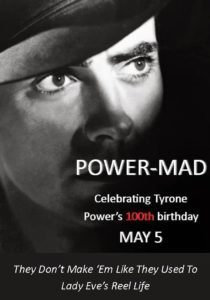 Zanuck cast about 20th Century Fox for someone similar. Among his first inclinations was to test Richard Greene (gasp!). In Ty Power, already in the upper echelon of stardom through successes in films including Marie Antoinette, Son of Fury, Suez, and Jesse James, Zanuck saw potential. In Power, a dramatically more versatile actor than Flynn, Zanuck found his answer.
Zanuck cast about 20th Century Fox for someone similar. Among his first inclinations was to test Richard Greene (gasp!). In Ty Power, already in the upper echelon of stardom through successes in films including Marie Antoinette, Son of Fury, Suez, and Jesse James, Zanuck saw potential. In Power, a dramatically more versatile actor than Flynn, Zanuck found his answer.
Zanuck hand-picked carefully the first picture to explore this new persona. The result was 1940’s The Mark of Zorro. Originally made under the same name as a silent picture in 1920 staring Douglas Fairbanks, the 1940 version continued the now traditional costume of black, creating somewhat of a caped crusader. More on that later.
The Curse of Capistrano, written by Johnston McCulley, provides the basis for the story, much as it did for the 1920 version. Fox didn’t purchase exclusive rights to the story, which accounts for other productions by other studios.
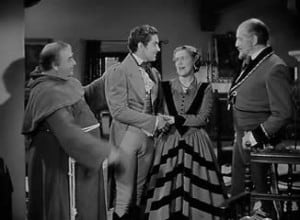 To give the film more of that swashbuckling feel, Fox brought three veterans of 1938’s smash hit The Adventures of Robin Hood along for the ride. Eugene Pallette (Friar Tuck in Robin Hood), Montagu Love (Bishop of the Black Canons) and Basil Rathbone (Sir Guy of Gisbourne) bring some additional heft as Fray Felipe, Don Alejandro, and Captain Esteban, respectively. Rathbone especially becomes a dynamic scene stealer as a foil to Power’s own portrayal of Don Diego. And Pallette virtually reprises his Friar Tuck role- I think Warner’s may have even loaned him the wardrobe for Zorro.
To give the film more of that swashbuckling feel, Fox brought three veterans of 1938’s smash hit The Adventures of Robin Hood along for the ride. Eugene Pallette (Friar Tuck in Robin Hood), Montagu Love (Bishop of the Black Canons) and Basil Rathbone (Sir Guy of Gisbourne) bring some additional heft as Fray Felipe, Don Alejandro, and Captain Esteban, respectively. Rathbone especially becomes a dynamic scene stealer as a foil to Power’s own portrayal of Don Diego. And Pallette virtually reprises his Friar Tuck role- I think Warner’s may have even loaned him the wardrobe for Zorro.
We won’t spend too much time on the plot, as most readers will know it- especially given the fairly recent reboot with Antonio Banderas, which touches some (okay, perhaps a few) of the key broad themes. Don Diego (Power) returns to his father’s home in Southern California after completing his education in Spain. Out of disgust with how the populace is being treated by the local Alcalde, he dons the cape and mask of Zorro and becomes their spokesman. Unbeknownst to all, he has become a skilled swordsman while abroad. In both personas he comes across Captain Esteban (Rathbone), who is contentious at best. Along the way he flirts with the ladies; with Lolita (Linda Darnell) and Inez (Gale Sondergaard) Quintero being the objects of his affections.
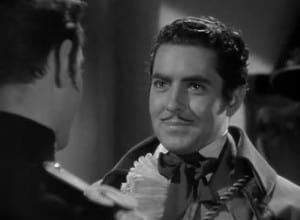 Power so completely filled the bill that The Mark of Zorro launched an entirely different part of his career, this one filled with swords and tights. He continued in the swashbuckling vein to become a serious competitor to Flynn- in more than mere swordplay. Although a thorough comparison is out of scope of this writing, suffice to say they both had their vices which led to their own respective untimely demises- both well before their time. Both passed far before their expiration date. Power went on with great success in the genre in The Black Swan, Prince of Foxes, The Black Rose, and Captain from Castile. However, unlike Flynn, Power’s typecasting was somewhat limited and he continued to show a range and depth to his material that Flynn frankly could not match (or at least wasn’t given the opportunity to by his boss, mogul Jack Warner).
Power so completely filled the bill that The Mark of Zorro launched an entirely different part of his career, this one filled with swords and tights. He continued in the swashbuckling vein to become a serious competitor to Flynn- in more than mere swordplay. Although a thorough comparison is out of scope of this writing, suffice to say they both had their vices which led to their own respective untimely demises- both well before their time. Both passed far before their expiration date. Power went on with great success in the genre in The Black Swan, Prince of Foxes, The Black Rose, and Captain from Castile. However, unlike Flynn, Power’s typecasting was somewhat limited and he continued to show a range and depth to his material that Flynn frankly could not match (or at least wasn’t given the opportunity to by his boss, mogul Jack Warner).
As for the film itself, it isn’t heavy lifting in any sense of the word but a truly enjoyable and fun ride for all. There is action for the kids, humor for the adults, and a good romantic theme as well for the ladies.
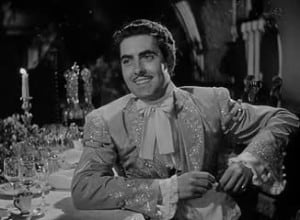 Power (and Rathbone, to be frank) makes the picture among the best of the genre. Utilizing a wide variety of facial expressions and vocal inflections, Power easily transitions from the shallow, foppish, and at times downright campy Don Diego to the brooding and menacing Zorro- and back again. And, though The New York Times originally paned Power’s performance in favor of that of Fairbanks, time has held Power closer to the sun and for most all his is viewed as the definitive portrayal.
Power (and Rathbone, to be frank) makes the picture among the best of the genre. Utilizing a wide variety of facial expressions and vocal inflections, Power easily transitions from the shallow, foppish, and at times downright campy Don Diego to the brooding and menacing Zorro- and back again. And, though The New York Times originally paned Power’s performance in favor of that of Fairbanks, time has held Power closer to the sun and for most all his is viewed as the definitive portrayal.
Much of Power’s Don Diego persona is downright comical, adding to our enjoyment. From his comments on the tepid nature of his scented bathwater to constantly picking himself clean of imaginary dust to that incessant dabbing with his lace handkerchief, Power is almost over the line of credulity. Though of course that is the point to begin with. Not many actors could pull off such a dramatic dichotomy. This range is one of the factors which makes it impossible to imagine Errol Flynn pulling it off with the same degree of success.
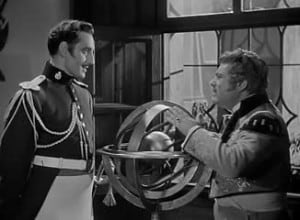 Perhaps my favorite scene- excluding the duel- sadly doesn’t feature Don Diego or Zorro. Rather, it features Esteban and the Alcade discussing politics over a rather odd globe. Esteban spins it after he delivers each piece of increasingly distressing news to the mayor, who stops it- with increased petulance each time. Finally the Alcalde alights on some good news and gives it a spin for himself. Very well done and I seem to recall this same gag repeated elsewhere, especially within the Peter Sellers library of Pink Panther films.
Perhaps my favorite scene- excluding the duel- sadly doesn’t feature Don Diego or Zorro. Rather, it features Esteban and the Alcade discussing politics over a rather odd globe. Esteban spins it after he delivers each piece of increasingly distressing news to the mayor, who stops it- with increased petulance each time. Finally the Alcalde alights on some good news and gives it a spin for himself. Very well done and I seem to recall this same gag repeated elsewhere, especially within the Peter Sellers library of Pink Panther films.
There are even more bits of humor and witty dialogue scattered throughout, though never with tongue as firmly in cheek as some of Flynn’s similar films. Though the ending is never in doubt, the film is still mighty enjoyable. With bits of drama, comedy, and romance, the only bit of significant action of note is the climactic final duel with Captain Esteban.
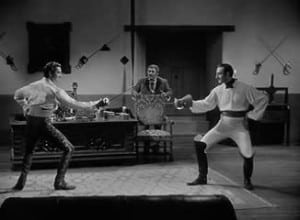 And what a duel it is- from this viewer’s mind one of (if not) the best in cinematic history. This duel and the final fight of The Adventures of Robin Hood are definitely a one-two punch as the cream of the crop. And yet, though Rathbone features in both of them (and both were choreographed by fencing master Fred Cavens), they are very different, and each highlight the lead’s abilities. Robin Hood is full of shadows, quick edits, and has a very acrobatic feel. Between flipping things over and jumping around in constant motion, Flynn is a very busy boy. In The Mark of Zorro, however, the feel is entirely different. Composed of several much longer shots, here the viewer truly gets the feel of the skill of the fencers involved. The fact that in Zorro the duel is contained in a relatively tight space (one room) drives additional suspense.
And what a duel it is- from this viewer’s mind one of (if not) the best in cinematic history. This duel and the final fight of The Adventures of Robin Hood are definitely a one-two punch as the cream of the crop. And yet, though Rathbone features in both of them (and both were choreographed by fencing master Fred Cavens), they are very different, and each highlight the lead’s abilities. Robin Hood is full of shadows, quick edits, and has a very acrobatic feel. Between flipping things over and jumping around in constant motion, Flynn is a very busy boy. In The Mark of Zorro, however, the feel is entirely different. Composed of several much longer shots, here the viewer truly gets the feel of the skill of the fencers involved. The fact that in Zorro the duel is contained in a relatively tight space (one room) drives additional suspense.
Rathbone of course, was (and still is) regarded as one of the best legitimate swordsmen ever to appear in Hollywood history. Power, on the other hand, learned the skill for Zorro but took to it well- with the proof in the nitrate negative. So much so that at one point Rathbone was quoted as saying, “Power was the most agile man with a sword I’ve ever faced before a camera. Tyrone could have fenced Flynn into a cocked hat.” High praise indeed. Though again, Rathbone never was victorious in an onscreen swordfight…..
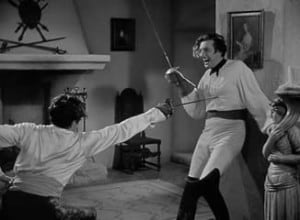 In viewing one can only agree with Rathbone’s more experienced eye in the matter. There is a fluidity- dare I say, an elegance- in Power’s fencing that Flynn’s lacks- or at least it does in Robin Hood– though in Flynn’s defense broadswords aren’t as naturally elegant to begin with. The lengthy shots highlight this, with Power’s left hand rarely moving from his hip, yet still appearing relaxed and flexible; ready to repond to Rathbone’s every move. As the fight continues, one sees Captain Esteban tire somewhat and grow frustrated, while Don Diego’s confidence swells until that final lunge, right under the “Z” Power carved in the wall roughly forty-five minutes earlier.
In viewing one can only agree with Rathbone’s more experienced eye in the matter. There is a fluidity- dare I say, an elegance- in Power’s fencing that Flynn’s lacks- or at least it does in Robin Hood– though in Flynn’s defense broadswords aren’t as naturally elegant to begin with. The lengthy shots highlight this, with Power’s left hand rarely moving from his hip, yet still appearing relaxed and flexible; ready to repond to Rathbone’s every move. As the fight continues, one sees Captain Esteban tire somewhat and grow frustrated, while Don Diego’s confidence swells until that final lunge, right under the “Z” Power carved in the wall roughly forty-five minutes earlier.
Beyond the stellar cast and fine performances we have a rousing score by Alfred Newman with an exciting main theme. It isn’t quite as powerful as the theme from Captain from Castile (currently still used by the USC Trojans), but still a wonderfully robust piece of music. Though rumors persist that the main theme is in fact a work of Hugo Friedhofer, I haven’t been able to confirm this.
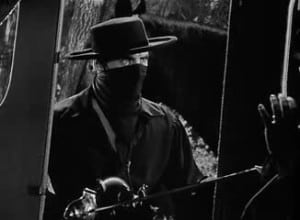 It is clear that Fox spared little expense (except for the dearthly lack of technicolor) but the final film isn’t without flaws. Though little plot is needed, it seems almost impossible that Zorro’s identity isn’t discovered much earlier in the film, as Don Diego makes little real effort to conceal it. The finale too, seems somewhat rushed and hurried and a “morning after” sequence may have been ideal. Then again, the ending wasn’t in doubt from the start, so perhaps a moot point. Lastly, those pants. Two words. Hays Code? (Please watch and tell me you understand.) Ay, Carumba!
It is clear that Fox spared little expense (except for the dearthly lack of technicolor) but the final film isn’t without flaws. Though little plot is needed, it seems almost impossible that Zorro’s identity isn’t discovered much earlier in the film, as Don Diego makes little real effort to conceal it. The finale too, seems somewhat rushed and hurried and a “morning after” sequence may have been ideal. Then again, the ending wasn’t in doubt from the start, so perhaps a moot point. Lastly, those pants. Two words. Hays Code? (Please watch and tell me you understand.) Ay, Carumba!
Though Power’s swashbuckling career continued with big budget genre pictures like Captain from Castile and The Black Swan, The Mark of Zorro was and is his best of the bunch. Although perhaps not quite up to the standard of then contemporary swashbucklers from Warner Brothers (who literally owned the market for both swashes and buckles at the time), The Mark of Zorro gives the Brothers Warner a run for their money and opened the door for other studios to enter the fray.
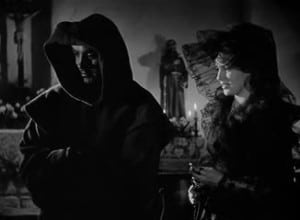 Oh, and lest we forget for those of you looking for us to tie off that loose with our ‘caped crusader’ reference….. For those who follow Batman, The Mark of Zorro is the film Bruce Wayne sees with his parents the night of their murder. And of course, Bruce Wayne becomes….you got it, Batman! Sadly, though many presume it is the 1940 version which inspired Wayne, it was most likely the earlier silent 1920 Douglas Fairbanks version, seeing how Batman first took flight in 1939- a year prior to Power’s Zorro.
Oh, and lest we forget for those of you looking for us to tie off that loose with our ‘caped crusader’ reference….. For those who follow Batman, The Mark of Zorro is the film Bruce Wayne sees with his parents the night of their murder. And of course, Bruce Wayne becomes….you got it, Batman! Sadly, though many presume it is the 1940 version which inspired Wayne, it was most likely the earlier silent 1920 Douglas Fairbanks version, seeing how Batman first took flight in 1939- a year prior to Power’s Zorro.
The Mark of Zorro is a must see for many reasons and is perhaps the best film of Power’s career. Doubt me not!
